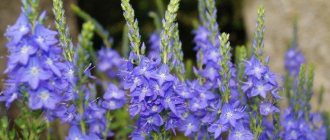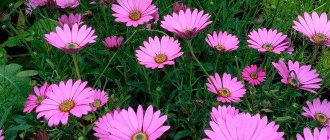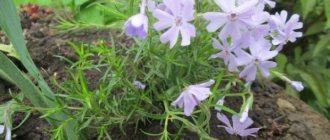general information
In the world, pansies are more often known as viola. And this garden culture has been known for many centuries, starting from the times of monastery gardens. Over time, hybrid forms appeared, and the most popular of them is the Wittrock viola.
Pansies have small, dark leaves with a serrated edge. The flowers are quite large, sometimes even up to 10 cm in diameter. They consist of four large petals, three of which look upward. But this is not the only form that exists.
Most often, the color of the upper and lower petals is different, and a contrasting eye is formed in the center. Depending on the conditions, pansies are grown as a biennial or perennial plant.
Photo: oir.mobi
Description and features
Pansies are called tricolor viola, popularly Ivan da Marya. They belong to the violet family. Plants exist as annuals, biennials and perennials.
Flowers are divided into spring and summer blooming. This is probably their uniqueness: any variety is suitable for choosing the flowering time.
It all depends on the landing time. The root is a brownish rod in the form of a rod with small branches. The stem extends from 10 to 30 cm. The inside is hollow, triangular, erect or branched. Single buds with five petals sit on triangular peduncles with two bracts near the flower.
Flower petals differ in size. Two of them are larger than the others. The color of the petals has a different range of shades, even black. There are spots in the center of the bud, and a picture emerges, like a muzzle.
The poetic name of the pansy has given rise to many legends. Many countries and even regions have their own answers about why pansies are called:
According to an ancient legend, the flower got its name in honor of the girl Anyuta, who could not stand the separation and injustice towards herself and died.
And it all started like in a fairy tale, the guy fell in love with the girl, she reciprocated. The seducer simply disappeared forever.
After her death, flowers with different colors stretched out on the grave, as if betraying her feelings: hope, resentment, sadness.
The Romans say that men spying on the goddess of love were turned into flowers with eyes.
In Russia, according to legend, a girl and a guy loved each other. Their parents separated them and married the guy to a rich girl. Anya died of melancholy.
Another legend, a girl, not getting a guy, died of melancholy. Flowers grew on the edge of the road, as if they continued to wait for their loved one.
Types of pansies
Even in the wild, there are several hundred varieties of pansies of all imaginable and unimaginable colors. It’s not for nothing that they are distributed all over the world, from the subtropics to the northern regions!
Fragrant pansies
This species is famous for its aroma and variety of blue and purple shades. It is this viola that is widely used in cosmetology and perfumery.
Photo: 9dach.ru
Horned pansy
A garden perennial that got its name because of the bizarre growth behind the bud. The height of the shoots reaches 25 cm, and the leaves are more elongated. The diameter of the flowers is generally about 5 cm.
Photo: viherkasvit.net
Monochrome pansies
All petals are painted in one uniform color. But veins, small spots or stripes on the lower petal are acceptable. Yellow and snow-white varieties are very popular.
Photo: pxhere.com
Two-color pansies
The most common category among gardeners is when the upper and lower petals are colored differently. It seems that all existing colors are found here.
Photo: pinterest.ru
Spotted pansy
Spots on buds and petals can be of several colors at once. There are decorative varieties with corrugated flowers. An excellent option for shady areas.
Photo: pixabay.com
Sororia
This variety is also called moth viola, and its fancy white and lilac petals really look like the wings of a moth. It is also a perennial with beautiful heart-shaped leaves.
Photo: prolisok.com.ua
Osteospermum (50 photos): types, planting and care in open ground
A little history
The tricolor violet received its romantic name due to its appearance. Its petals really resemble big eyes.
There is a legend that the girl Anyuta was waiting for her lover and, without waiting for him, died of melancholy. Unusual flowers grew on her grave, reminiscent of eyes continuously looking into the distance.
Different peoples have different versions of this legend, but they all talk about love and fidelity.
Caring for pansies
Pansies prefer a golden mean in everything - in temperature, watering and lighting. Most varieties feel quite comfortable in our latitudes and do not cause problems.
Temperature
Ideal temperature conditions for pansies are 12-22 degrees. They survive short-term changes normally, but do not survive prolonged frosts and droughts well.
Photo: zen.yandex.ru
Lighting
With a lack of sun, the flowers become smaller, and with too much sun, pansies may stop blooming altogether. The ideal duration of bright light is 5-6 hours a day.
Photo: 56441938444431.my-6-sotok.rf
Watering
Seedlings and cuttings need a constantly moist substrate, but they should not be flooded to prevent them from rotting. Adult plants are watered with warm water as the soil dries, very carefully and strictly at the root. Leaves and flowers should not be wetted.
Photo: wallbox.ru
The soil
Ready-made soil for violets is best suited, especially when it comes to seedlings. In the garden, in the fall, we advise you to carefully dig up the area and, if necessary, apply fertilizer.
Photo: pinterest.ru
Fertilizers and fertilizing
Pansies like regular feeding every 2-3 weeks. Ready-made complexes for violets are still suitable, and in addition to them you can use fertilizers with phosphorus and potassium.
Photo: dobro.ru
Trimming
Old, growing bushes can be pruned, and at the same time cuttings can be used for propagation. And young bushes tolerate pinching well if you want to give them a more compact shape.
Photo: pxhere.com
Wintering
With the onset of cold weather, trim the bush, stop watering and fertilizing and cover the planting with spruce branches or leaves. This is how perennial frost-resistant varieties will survive the winter. At the beginning of spring, immediately remove the shelter so that the roots do not begin to rot.
Photo: florino.net
Marigolds (50 photos): types, care and planting in open ground
Planting and propagation
The easiest way to propagate pansies is simple self-seeding. New seeds will germinate by the end of summer, and will just adapt and acclimatize by winter. There is only one drawback of this method - it is difficult to obtain a clear landing shape. But in the same way, you can sow the seeds yourself immediately after they ripen.
To achieve flowering as early as possible, pansies are planted as seedlings in February. Then the bushes will bloom in the coming summer, but as an annual. It is enough to slightly bury the seeds in loose soil, water and leave under the film. After just a couple of weeks, the seedlings can be harvested.
The seedlings are transplanted into open ground in May. It will have time to take root and bloom by summer. You should not pick off flowers either during or after flowering. However, this applies to any violets.
Pansies can also be propagated by cuttings. You need healthy tops with 2-3 nodes, which are buried about 5 cm into the ground and left in the shade. After 3 weeks, if there is sufficient moisture, they will take root. And if you plant them in May, by summer they will even bloom for the first time. Using the same principle, old overgrown plants are rejuvenated.
Photo: garden4therapy.wordpress.com
Sowing seeds in open ground
In June, Pansy flower seeds are sown in a prepared place in the flowerbed. It is not worth deepening them too much, no more than 1-1.5 cm. Sprinkle them with a layer of earth on top and lightly compact them.
We recommend reading:
- Flowers for a flower bed blooming all summer until autumn: photo and name
- Fern and its types: characteristics, features and propagation tips
- Autumn flowers in the garden: photos and names
After 2 true leaves appear on the seedlings, they are plucked. At the same time, the roots of the seedlings need to be shortened to stimulate the development of new roots. The distance between seedlings should be 10-25 cm, which depends on the variety.
Plants planted in this way should be covered with a layer of foliage or spruce branches for the winter. They will begin flowering next year, with the onset of warmer weather.
Pest and disease control
Natural types of pansies rarely get sick, but selected hybrids are susceptible to fungus. The most dangerous problems are stem or root rot, which appear as rotting spots closer to the ground. Urgently remove diseased plants, dry the soil and sprinkle with crushed coal.
Less common are powdery mildew or rust. In the first case, a whitish coating appears, and in the second, red, lumpy spots appear. Removing damaged parts and treating with fungicides will help.
The most common pests of pansies are aphids, spider mites and slugs. Due to the invasion of aphids, the shoots gradually become deformed and die, the mite leaves a web, and slugs simply eat the planting. Remove pests mechanically, spray the plants with a soap solution, and use insecticides if necessary.
Photo: pixnio.com
Eschscholzia (60 photos): types, planting and care in open ground
Pansies – photo
Thanks to their fancy color, pansies always look fabulous and exotic. It's hard to believe that they are actually completely simple and unpretentious. Look how good they are in group plantings!
Photo: m.2gis.ru Photo: wallbox.ru
Photo: m.fotostrana.ru
Photo: wallpapers.net
Photo: nevseoboi.com.ua
Photo: wallbox.ru
Photo: cvetyphoto.blogspot.com
Photo: tchudesa.ru Photo: fotoload.ru
Photo: pxhere.com
Photo: zastavki.com
Photo: vaseninasu.blogspot.com Photo: kartinki-cvetov.ru
Photo: pixabay.com
Photo: ru.wallpaper.mob.org
Photo: funart.pro
Photo: eldomo.ru Photo: plodovie.ru
Photo: nat-geo.ru
Photo: zen.yandex.by
Photo: funart.pro
Photo: proprikol.ru
Photo: cvetkoffandbuketoff.ru
Photo: wallbox.ru
Did you like the post? Subscribe to our channel in Yandex.Zen, it really helps us in our development!











